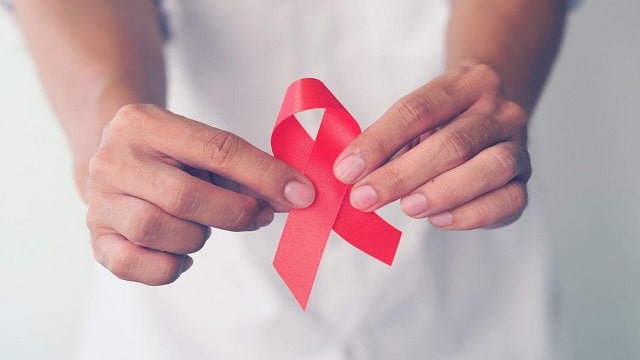AIDS Definition, Reason, Symptoms, Treatment
Acquired immune deficiency syndrome (AIDS) is a disease caused by the HIV virus. Learn about the symptoms, diagnosis, and treatment of AIDS.
Acquired immune deficiency syndrome or AIDS is the final stage of the human immunodeficiency virus (HIV) infection.
However, not all people with HIV will become HIV/AIDS.
AIDS is a syndrome or collection of disease symptoms caused by a very weak immune system.
Infections that should not be severe in normal people can be deadly in people with AIDS.
Until now there is no treatment that can cure HIV / AIDS.
HIV treatment aims to support the immune system so that sufferers can live normal, healthy lives and do not develop AIDS.
The following is an in-depth explanation of what AIDS is. According to Magnet Brains HIV and AIDS Explained in a Simple Way in Hindi | HIV Mechanism of Action | Mini Jankaari Series
Reason
The cause of AIDS is the HIV virus.
This virus attacks the immune system which is supposed to function to fight infection.
The HIV virus itself destroys white blood cells called CD4 cells. Viruses also make copies of their bodies inside these cells.
As a result, the immune system decreases and makes it difficult for the body to fight infection.
If the patient does not get treatment, HIV can become AIDS within 10-15 years.
The HIV virus is transmitted through direct contact with the patient’s blood and body fluids, such as sperm, vaginal fluids, and breast milk.
In many cases, transmission can be through the use of needles such as injecting drug users.
Another case is in sexual intercourse because small wounds often occur that are not realized.
Symptoms
Symptoms of AIDS include serious infections, such as:
1. Prolonged diarrhea (more than 1 week)
2. Nausea and vomiting
3. Cold sweat at night
4. Fever
5. Dry cough
6. Skin and mouth problems such as yeast infection
7. Repeated and frequent infections
8. Got a serious illness
9. Excessive weakness and fatigue
10. Weight loss
11. Swollen lymph nodes in the neck, armpit, or groin area that occur for a long time
12. Canker sores in the mouth, anus, or genital area
13. Lung infection (pneumonia)
14. Memory loss or other neurological disorders
15. Depression, confusion, personality changes
16. Spots on the mouth, nose, or eyelids. The patches can be reddish, pink, purple, or brown
Diagnosis
The doctor will determine the diagnosis of HIV / AIDS from the patient’s symptoms.
Investigations are needed, especially to detect the presence of antibodies to the HIV virus and CD4 cell count.
The first test to detect HIV antibodies is an enzyme immunoassay (EIA) test. If positive, a confirmatory test will be performed with a Western Blot test.
People with normal immune systems have between 500-1500 CD4 cells.
Meanwhile, people with HIV who have experienced a decline in CD4 cells, the number drops to below 200 and is said to be HIV/AIDS.
Other supporting examinations aim to find out what opportunistic infections that attack people with HIV/AIDS, such as tuberculosis, pneumonia, some types of cancer, and so on.
Treatment
Until now there is no treatment that can cure HIV / AIDS.
The goal of AIDS treatment is to stop the progression of the disease and to support the sufferer to lead a normal life.
It is important to start HIV treatment early so as not to become HIV AIDS.
Treatment is carried out using antiretroviral drugs (ARVs). The drug fights HIV infection and slows the spread of the virus in the body.
There are several classes of ARV drugs, such as:
1. protease inhibitors
2. integrase inhibitors
3. nucleoside/nucleotide reverse transcriptase inhibitors (NRTIs)
4. non-nucleoside reverse transcriptase inhibitors (NNRTIs)
5. chemokine co-receptor antagonists
entry inhibitors
Usually, treatment is carried out using a combination of several kinds of drugs.
The type of drug combination varies, depending on each patient. AIDS treatment must be done for life.
Medication should also be taken regularly on the same schedule.
Patients should control and check regularly with a doctor to change the dose of AIDS drugs if needed.
Here are some of the side effects of the treatment:
1. nauseous
2. weak
3. diarrhea
4. headache
5. skin rash
Prevention
How to avoid AIDS is to prevent the transmission of the HIV virus.
This can be done by avoiding direct contact with the patient’s fluids and blood.
In addition, also avoid the use of needles and free sexual intercourse.
Using protection such as condoms during sexual intercourse can prevent the transmission of the HIV virus.
It is also important to carry out early detection and treatment so that HIV does not become a more severe stage, namely AIDS.
Complications
When you have AIDS, your immune system tends to be weak, making it easy for opportunistic infections to occur.
This infection rarely affects normal, healthy people.
Unlike people with AIDS, opportunistic infections can lead to serious illnesses.
Examples of complications due to opportunistic infections are:
1. on the brain: cryptococcal meningitis, HIV-related encephalopathy, toxoplasmosis
2. Eyes: CMV ( cytomegalovirus) infection
3. in the gastrointestinal tract: cryptosporidiosis, CMV infection, Mycobacterium Avium Complex
4. on the genitals: candidiasis, herpes simplex, HPV infection
5. in the liver: hepatitis (especially hepatitis B and hepatitis C )
6. in the lungs: tuberculosis, recurrent pneumonia
7. on the lymphatic system: non-Hodgkin’s lymphoma
8. of the mouth and throat: candidiasis
9. on the skin: herpes simplex, Kaposi’s sarcoma, herpes zoster.
